1.初始化流程

在SpawnPlayerCameraManager中创建CameraManager并进行初始化
void APlayerController::SpawnPlayerCameraManager()
{
// servers and owning clients get cameras
// If no archetype specified, spawn an Engine.PlayerCameraManager. NOTE all games should specify an archetype.
FActorSpawnParameters SpawnInfo;
SpawnInfo.Owner = this;
SpawnInfo.Instigator = GetInstigator();
SpawnInfo.ObjectFlags |= RF_Transient; // We never want to save camera managers into a map
if (PlayerCameraManagerClass != NULL)
{
PlayerCameraManager = GetWorld()->SpawnActor<APlayerCameraManager>(PlayerCameraManagerClass, SpawnInfo);
}
else
{
PlayerCameraManager = GetWorld()->SpawnActor<APlayerCameraManager>(SpawnInfo);
}
if (PlayerCameraManager != NULL)
{
PlayerCameraManager->InitializeFor(this);
}
else
{
UE_LOG(LogPlayerController, Log, TEXT("Couldn't Spawn PlayerCameraManager for Player!!") );
}
}InitializeFor为给定的关联PlayerController初始化这个PlayerCameraManager
void APlayerCameraManager::InitializeFor(APlayerController* PC)
{
FMinimalViewInfo DefaultFOVCache = GetCameraCacheView();
DefaultFOVCache.FOV = DefaultFOV;
SetCameraCachePOV(DefaultFOVCache);
PCOwner = PC;
SetViewTarget(PC);
// set the level default scale
SetDesiredColorScale(GetWorldSettings()->DefaultColorScale, 5.f);
// Force camera update so it doesn't sit at (0,0,0) for a full tick.
// This can have side effects with streaming.
UpdateCamera(0.f);
}2.相机更新流程

2.1 CameraManager::UpdateCamera
内部执行两个操作:
1. 调用DoupdateCamera()函数
2. 如果CameraManager.buseclientsidecamerupupdates设置为True,客户端将复制相机位置到服务器,其中,会将旋转压缩到4字节
void APlayerCameraManager::UpdateCamera(float DeltaTime)
{
check(PCOwner != nullptr);
if ((PCOwner->Player && PCOwner->IsLocalPlayerController()) || !bUseClientSideCameraUpdates || bDebugClientSideCamera)
{
DoUpdateCamera(DeltaTime);
...................
if (bShouldSendClientSideCameraUpdate && IsNetMode(NM_Client))
{
......................
}
}
}2.2 CameraManager::DoUpdateCamera
实际更新相机的函数
1. 颜色插值变化
// update color scale interpolation
if (bEnableColorScaleInterp)
{
float BlendPct = FMath::Clamp((GetWorld()->TimeSeconds - ColorScaleInterpStartTime) / ColorScaleInterpDuration, 0.f, 1.0f);
ColorScale = FMath::Lerp(OriginalColorScale, DesiredColorScale, BlendPct);
// if we've maxed
if (BlendPct == 1.0f)
{
// disable further interpolation
bEnableColorScaleInterp = false;
}
}2.调用UpdateViewTarget()处理ViewTarget的更新
// Don't update outgoing viewtarget during an interpolation when bLockOutgoing is set.
if ((PendingViewTarget.Target == NULL) || !BlendParams.bLockOutgoing)
{
// Update current view target
ViewTarget.CheckViewTarget(PCOwner);
UpdateViewTarget(ViewTarget, DeltaTime);
}
// our camera is now viewing there
NewPOV = ViewTarget.POV;3.ViewTarget和PendingViewTarget之间的融合(过渡)逻辑
// if we have a pending view target, perform transition from one to another.
if (PendingViewTarget.Target != NULL)
{
BlendTimeToGo -= DeltaTime;
// Update pending view target
PendingViewTarget.CheckViewTarget(PCOwner);
UpdateViewTarget(PendingViewTarget, DeltaTime);
// blend....
if (BlendTimeToGo > 0)
{
float DurationPct = (BlendParams.BlendTime - BlendTimeToGo) / BlendParams.BlendTime;
float BlendPct = 0.f;
switch (BlendParams.BlendFunction)
{
.........
}
}
else
{
// we're done blending, set new view target
ViewTarget = PendingViewTarget;
// clear pending view target
PendingViewTarget.Target = NULL;
BlendTimeToGo = 0;
// our camera is now viewing there
NewPOV = PendingViewTarget.POV;
OnBlendComplete().Broadcast();
}
}4.处理CameraFade
if (bEnableFading)
{
if (bAutoAnimateFade)
{
FadeTimeRemaining = FMath::Max(FadeTimeRemaining - DeltaTime, 0.0f);
if (FadeTime > 0.0f)
{
FadeAmount = FadeAlpha.X + ((1.f - FadeTimeRemaining / FadeTime) * (FadeAlpha.Y - FadeAlpha.X));
}
if ((bHoldFadeWhenFinished == false) && (FadeTimeRemaining <= 0.f))
{
// done
StopCameraFade();
}
}
if (bFadeAudio)
{
ApplyAudioFade();
}
}5.缓存相机数据FillCameraCache,用于渲染
if (AllowPhotographyMode())
{
const bool bPhotographyCausedCameraCut = UpdatePhotographyCamera(NewPOV);
bGameCameraCutThisFrame = bGameCameraCutThisFrame || bPhotographyCausedCameraCut;
}
// Cache results
FillCameraCache(NewPOV);2.3 APlayerCameraManager::UpdateViewTarget
UpdateViewTarget 根据 ViewTarget 内的 Target 计算对应的 POV 信息(核心逻辑)
1. 如果TargetActor是CameraActor类型的,调用其CameraComponent的GetCameraView()方法
if (ACameraActor* CamActor = Cast<ACameraActor>(OutVT.Target))
{
// Viewing through a camera actor.
CamActor->GetCameraComponent()->GetCameraView(DeltaTime, OutVT.POV);
}2. 否则根据设置的CameraStyle进行相应的处理,如果CameraStyle为默认值则调用UpdateViewTargetInternal()方法
static const FName NAME_Fixed = FName(TEXT("Fixed"));
static const FName NAME_ThirdPerson = FName(TEXT("ThirdPerson"));
static const FName NAME_FreeCam = FName(TEXT("FreeCam"));
static const FName NAME_FreeCam_Default = FName(TEXT("FreeCam_Default"));
static const FName NAME_FirstPerson = FName(TEXT("FirstPerson"));
if (CameraStyle == NAME_Fixed)
{
...........
}
else if (CameraStyle == NAME_ThirdPerson || CameraStyle == NAME_FreeCam || CameraStyle == NAME_FreeCam_Default)
{
......
}
else if (CameraStyle == NAME_FirstPerson)
{
.......
}
else
{
UpdateViewTargetInternal(OutVT, DeltaTime);
}
}3. ApplyCameraModifiers 处理特殊的镜头需求;比如:CameraShake、粒子效果等
if (!bDoNotApplyModifiers || bAlwaysApplyModifiers)
{
// Apply camera modifiers at the end (view shakes for example)
ApplyCameraModifiers(DeltaTime, OutVT.POV);
}4. 更新CameraManager的位置以及任何附加的相机镜头效果
// Synchronize the actor with the view target results
SetActorLocationAndRotation(OutVT.POV.Location, OutVT.POV.Rotation, false);
UpdateCameraLensEffects(OutVT);2.4 CameraManager::UpdateViewTargetInternal
本质上也是为了调用CameraComponent的GetCameraView()方法
void APlayerCameraManager::UpdateViewTargetInternal(FTViewTarget& OutVT, float DeltaTime)
{
if (OutVT.Target)
{
FVector OutLocation;
FRotator OutRotation;
float OutFOV;
if (BlueprintUpdateCamera(OutVT.Target, OutLocation, OutRotation, OutFOV))
{
OutVT.POV.Location = OutLocation;
OutVT.POV.Rotation = OutRotation;
OutVT.POV.FOV = OutFOV;
}
else
{
OutVT.Target->CalcCamera(DeltaTime, OutVT.POV);
}
}
}优先调用蓝图中的实现,若没有,则调用Actor中的CalcCamera()方法
AActor::CalcCamera的实现如下:
void AActor::CalcCamera(float DeltaTime, FMinimalViewInfo& OutResult)
{
if (bFindCameraComponentWhenViewTarget)
{
// Look for the first active camera component and use that for the view
TInlineComponentArray<UCameraComponent*> Cameras;
GetComponents(/*out*/ Cameras);
for (UCameraComponent* CameraComponent : Cameras)
{
if (CameraComponent->IsActive())
{
CameraComponent->GetCameraView(DeltaTime, OutResult);
return;
}
}
}
GetActorEyesViewPoint(OutResult.Location, OutResult.Rotation);
}会在Actor中寻找CameraComponent,然后调用CameraComponent::GetCameraView()方法
如果没有找到Actor身上的CameraComponent,则调用GetActorEyesViewPoint()计算
void AActor::GetActorEyesViewPoint( FVector& OutLocation, FRotator& OutRotation ) const
{
OutLocation = GetActorLocation();
OutRotation = GetActorRotation();
}2.5 UCameraComponent::GetCameraView
返回相机的视角。设置FMinimalViewInfo里的各项参数
1. 首先执行bUsePawnControlRotation = true的逻辑
if (bUsePawnControlRotation)
{
const APawn* OwningPawn = Cast<APawn>(GetOwner());
const AController* OwningController = OwningPawn ? OwningPawn->GetController() : nullptr;
if (OwningController && OwningController->IsLocalPlayerController())
{
const FRotator PawnViewRotation = OwningPawn->GetViewRotation();
if (!PawnViewRotation.Equals(GetComponentRotation()))
{
SetWorldRotation(PawnViewRotation);
}
}
}2. 设置Location和Rotation
if (bUseAdditiveOffset)
{
FTransform OffsetCamToBaseCam = AdditiveOffset;
FTransform BaseCamToWorld = GetComponentToWorld();
FTransform OffsetCamToWorld = OffsetCamToBaseCam * BaseCamToWorld;
DesiredView.Location = OffsetCamToWorld.GetLocation();
DesiredView.Rotation = OffsetCamToWorld.Rotator();
}
else
{
DesiredView.Location = GetComponentLocation();
DesiredView.Rotation = GetComponentRotation();
}3. 其余各项FOV、AspectRation等
DesiredView.FOV = bUseAdditiveOffset ? (FieldOfView + AdditiveFOVOffset) : FieldOfView;
DesiredView.AspectRatio = AspectRatio;
DesiredView.bConstrainAspectRatio = bConstrainAspectRatio;
DesiredView.bUseFieldOfViewForLOD = bUseFieldOfViewForLOD;
DesiredView.ProjectionMode = ProjectionMode;
DesiredView.OrthoWidth = OrthoWidth;
DesiredView.OrthoNearClipPlane = OrthoNearClipPlane;
DesiredView.OrthoFarClipPlane = OrthoFarClipPlane;
if (bOverrideAspectRatioAxisConstraint)
{
DesiredView.AspectRatioAxisConstraint = AspectRatioAxisConstraint;
}
// See if the CameraActor wants to override the PostProcess settings used.
DesiredView.PostProcessBlendWeight = PostProcessBlendWeight;
if (PostProcessBlendWeight > 0.0f)
{
DesiredView.PostProcessSettings = PostProcessSettings;
}
// If this camera component has a motion vector simumlation transform, use that for the current view's previous transform
DesiredView.PreviousViewTransform = FMotionVectorSimulation::Get().GetPreviousTransform(this);






 本文详细描述了UnrealEngine中PlayerCameraManager的初始化过程以及相机更新机制,包括相机位置同步、视图目标处理、相机风格切换、镜头效果应用和视点计算等关键步骤。
本文详细描述了UnrealEngine中PlayerCameraManager的初始化过程以及相机更新机制,包括相机位置同步、视图目标处理、相机风格切换、镜头效果应用和视点计算等关键步骤。














 232
232











 被折叠的 条评论
为什么被折叠?
被折叠的 条评论
为什么被折叠?








